There are operating systems like Windows or Macintosh, and then there’s Linux. Created with high-volume and multithreading applications in mind, Linux is perhaps one of the most widely applied but also the most ‘anonymous’ operating systems of all.
For instance, did you know that the governments of both China and Russia use Linux-based OS? Or that over 95% of servers running the top one million domains are powered by Linux? But there’s more!
So, buckle up and get ready to dive into our list of the most compelling Linux statistics and facts.
Linux Statistics and Facts (The Highlights)
- 38.7% of websites whose operating systems are known use Linux.
- Linux kernel powers a staggering 71.8% of smartphones.
- The market share of Linux in 2022 was valued at around $7.48 billion.
- Linux owns 1.26% of the operating system market share worldwide.
- Linux is the “beating heart” of all top 500 supercomputers.
- There are 48.07 million Linux users.
- 45% of software developers across the globe use Linux.
- There are 600 Linux distributions.
- Of all Linux-based websites, 31.8% run on Ubuntu.
- 52% of employees at the Linux Foundation are women.
Linux Usage Statistics
38.7% of websites whose operating systems are known use Linux.
Linux adoption is particularly strong among the top 1,000 websites, accounting for 49.4% of them. It has equal 47.5% portions among the top 10,000 and the top 100,000 websites, while its share among the top one million websites is 46.6%.
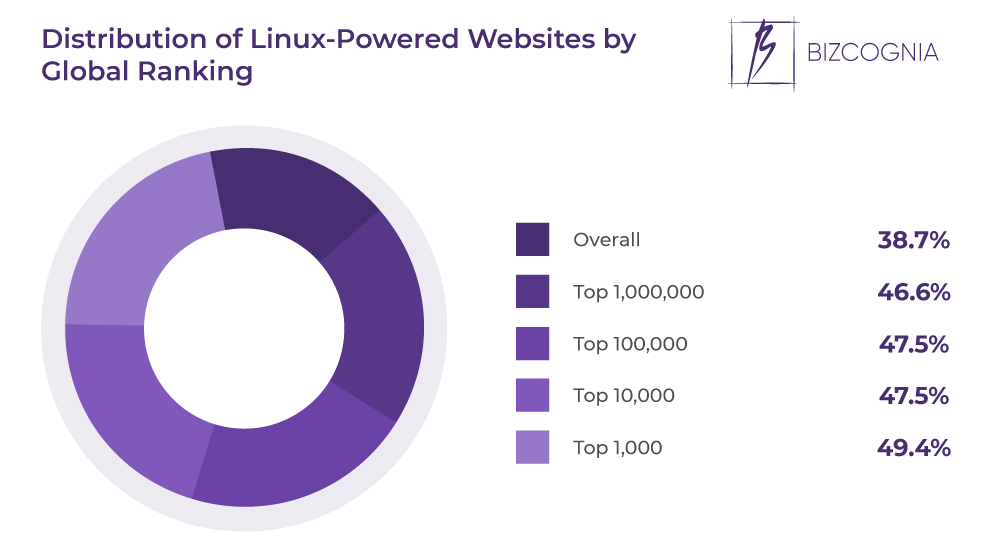
Linux kernel powers a staggering 71.8% of smartphones.
Both Google OS and Android were built on the Linux kernel which in a way means it is the creator of the world’s most used smartphones.
And while some might argue this is not directly related to Linux statistics, fact is, 71.8% of smartphones run on Android which means they run on Linux. Of course, this is a claim that has been supported by Google as even the open-source chief of Google, Chris DiBona, had mentioned that the Android is a ‘Linux desktop dream come true’.
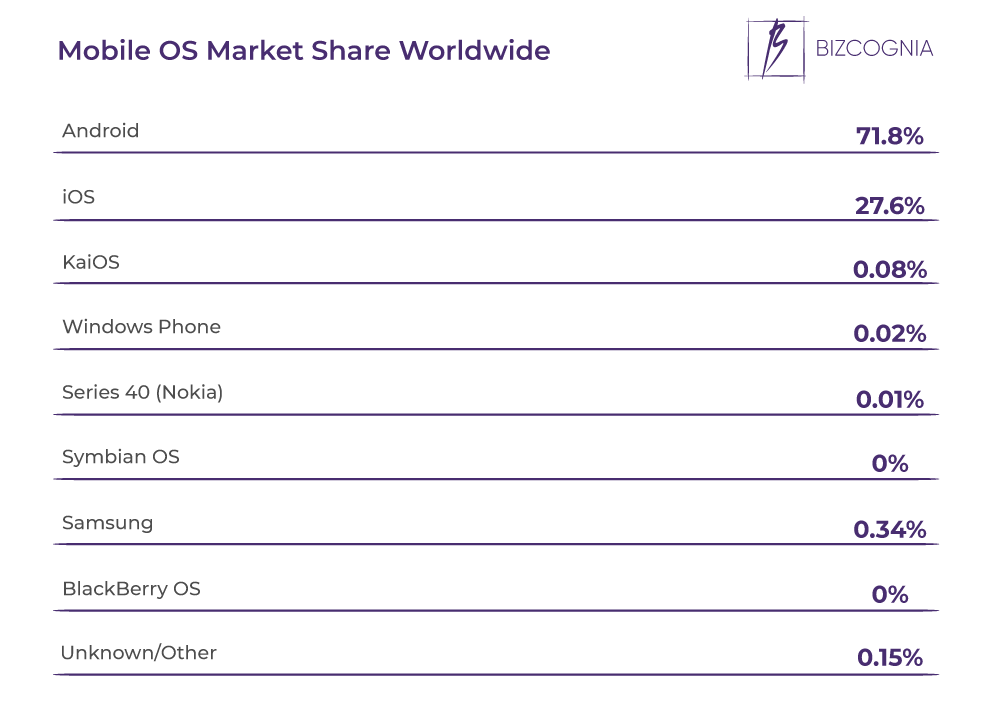
With 91,852 lines changed, Oracle is the top contributor to the Linux Kernel.
AMD follows closely with 89,761 lines, while Google ranks third with 56,504 lines.
Huawei and Intel are the leaders when it comes to the number of changesets, with 1,281 and 1,254, respectively.
Linux Kernel entered 2020 with around 28 million lines of code.
Linux popularity is high among programmers and companies which is why many contribute to expanding its code. In 2020, the Git repository of Linux had 27,852,148 lines of code distributed among 66,492 files.
The lines of code were generated through 887,925 commits, by 21,074 different authors, the most popular of which was Linus Torvalds himself, along with Intel and Red Hat.
Linux Market Share Statistics
The market share of Linux in 2022 was valued at around $7.48 billion.
The above figure is expected to grow at a CAGR of 18.7% by 2028, reaching $20.93 billion.
Linux owns 1.26% of the operating system market share worldwide.
As of April 2023, Android and Windows have much bigger pieces of the pie, or 37.67% and 27.83%, respectively.
As expected, in the realm of desktops, the market share of Linux is slightly higher amounting to 2.83% in April 2023, a figure that indicates a 13.65% spike when compared to the year before.
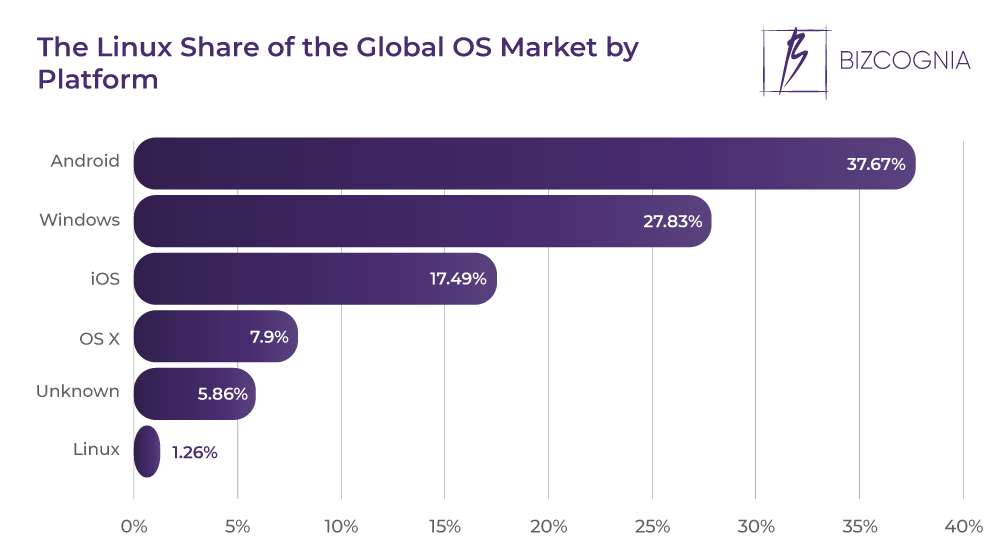
Linux powers 2.76% of computer devices worldwide.
The above figure makes it the third most-popular computer operating system worldwide (running on desktops, tablets, and consoles). Windows tops the list with a 70.39% share, while MacOS ranks second with 14.55% of the market share, as of January 2023.
13.6% of servers worldwide use Linux.
The above figure puts Linux right behind Windows which accounts for 72.1% of server usage worldwide.
In the Linux vs Windows server market share battle, albeit minor, the first is noting an increasing trend in usage, while the opposite applies to the latter.
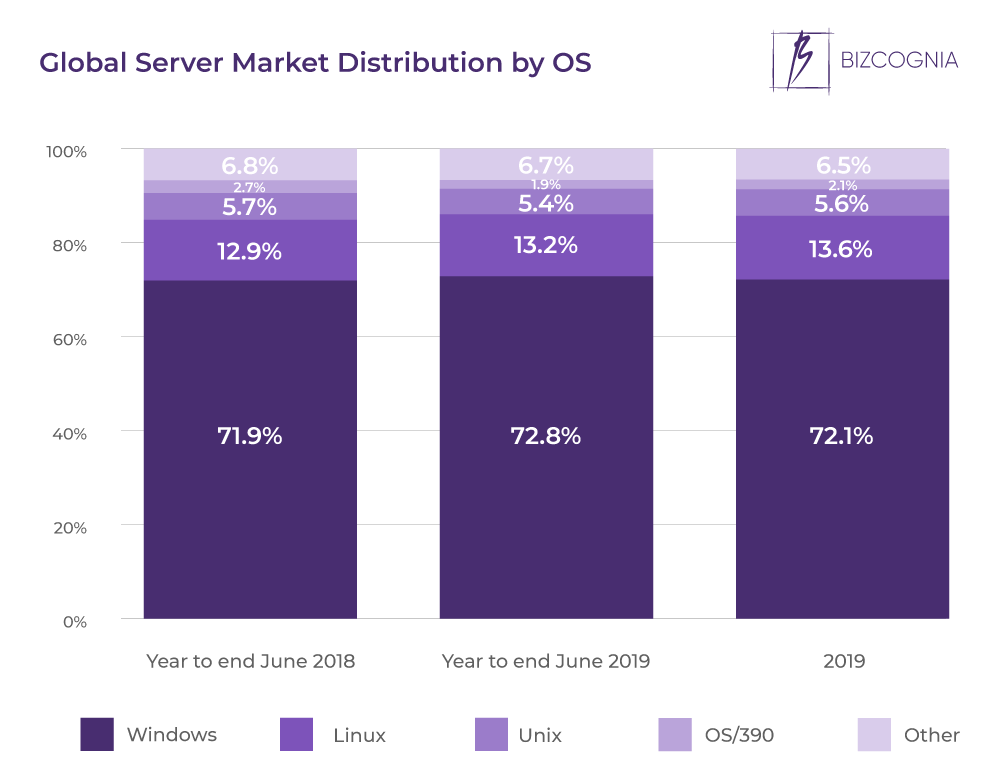
Linux is the “beating heart” of all top 500 supercomputers.
Linux usage stats reveal that the above figure has been at 100% since November 2017.
The main reason for this is the scalability and flexibility of Linux in supporting high-performance computing such as the ones able to calculate around 1,018 flating point operations per second. But also because of Linux’s continuous support in the field of AI and machine learning.
Linux User Statistics
There are 48.07 million Linux users.
With 2.2 billion users, Android is the most used operating system while Windows comes second with 1.5 billion users.
If you compare the number of Linux users to other OS, it might seem like the penguin OS is barely surviving. But, considering Chrome OS and Android are based on Linux, the OS has a much more substantial contribution to the market.
45% of software developers across the globe use Linux.
The above figure marks a two percentage point decrease compared to the previous year, and a five percentage point drop compared to 2020, when Linux usage for software development peaked at 50% in the five-year period between 2019 and 2022.
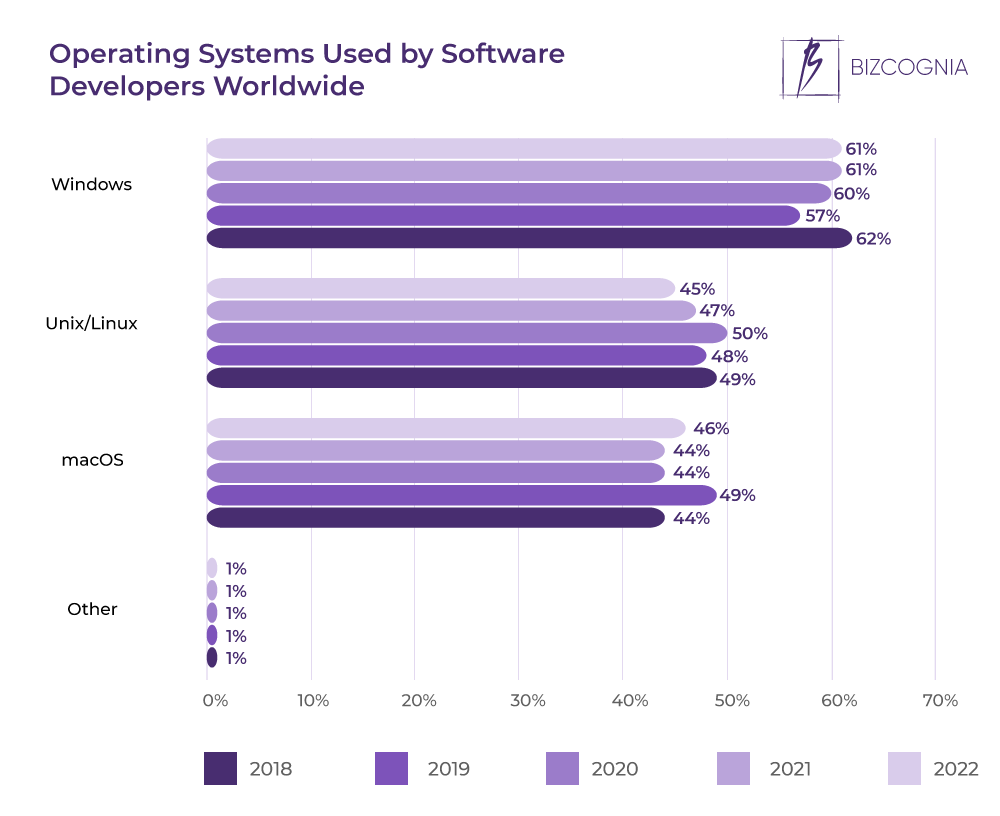
Linux Distribution Usage Statistics
There are 600 Linux distributions.
Besides the 500 Linux distributions that are in active development, the most popular Linux distros include Debian, Red Hat, Ubuntu, Manjaro, and Linux Mint.
Of all Linux-based websites, 31.8% run on Ubuntu.
Debian is the second most-popular with 16.8%, followed by CentOS with 8.2%.
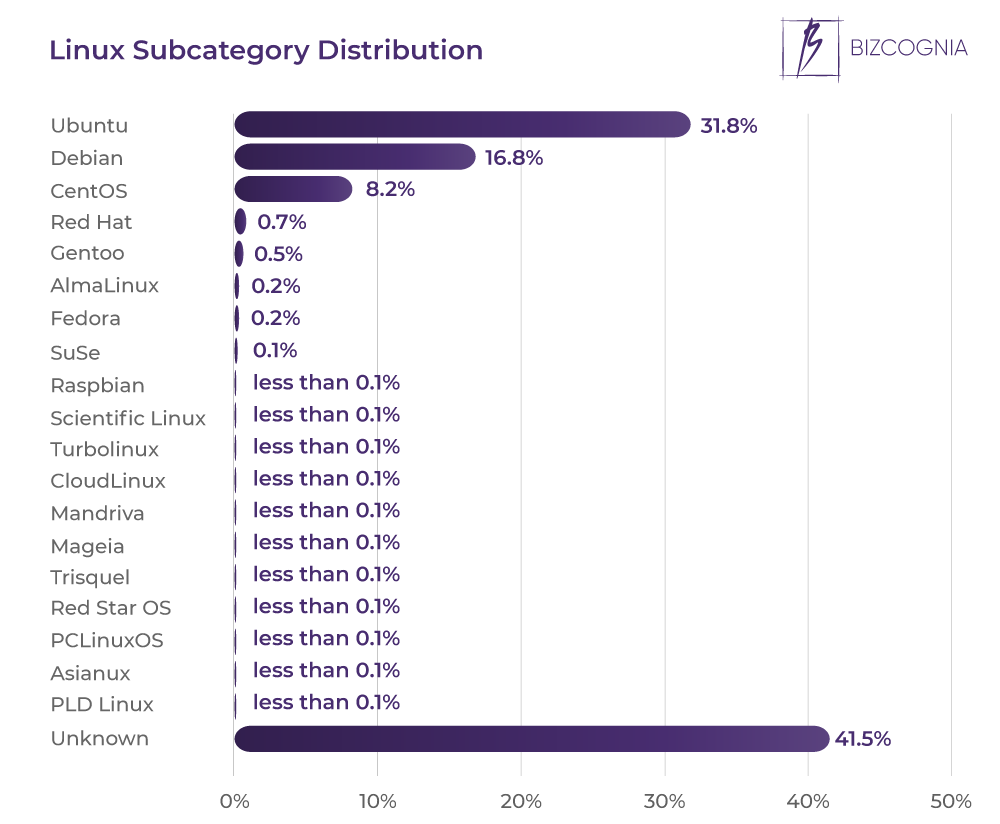
Over four million live websites run on Linux-based Ubuntu.
Linux distro usage statistics further reveal that the Ubuntu market share among the top 10,000 websites is 15.14%. It accounts for 13.35% of the top 100,000 websites, and 7.89% of the top million.
The US tops the list of countries with the highest number of Ubuntu websites, with 1.8 million of them. Germany has 248k and Russia has 141k websites running on Ubuntu. The list of the top five is rounded by the UK and the Netherlands, with 126k and 105k websites, respectively.
Red Hat Enterprise Linux and Ubuntu Server lead the Linux server market with a 40% share each.
Linux server statistics reveal that Debian ranks second with a 20% share, followed by Oracle Linux (18%), CentOS (16%), and Ubuntu Core (14%) in the top five.
Used by 21.2% of gamers, SteamOS Holo is the most used Linux OS on Steam.
Arch Linux and Ubuntu claim the second and third spots with 10.36% and 9,61%, respectively. Freedesktop.org and Manjaro round the top five with 7.1% and 6.95%, respectively, while other Linux distros are attributed to 44.79% of Linux users on Steam.
The German Government is replacing 25,000 Windows computers with Linux.
It appears the Linux distro market share will be expanding in the upcoming years, especially in governmental sectors.
In 2002, the Bank of Brazil decided to migrate all its desktops, ATMs and servers to the openSUSE Linux distro. Some years later, as Linux popularity grew, the Government of Venezuela introduced the Debian base distribution, Canaima in all public administration offices.
Recently, in an effort to reduce costs, the German Government announced they will be moving all PCs to Linux and that this process should be concluded by 2026.
Working With Linux
52% of employees at the Linux Foundation are women.
The above figure is 58% higher than the one in other large technology companies.
Additionally, women hold 31.8% of executive roles at the Linux Foundation, which is nearly three times higher than the average in large tech companies.
Women also hold 28% of board seats at the Linux Foundation, nearly double the figure in large technology companies.
87.3% of Linux administrators are men.
Out of over 30,000 Linux administrators in the US, the remaining 12.7% who are women also earn 95% of their male counterparts.
Additionally, the share of women Linux administrators has been fluctuating on a decreasing trend since 2012, when they accounted for 17.06% of employees on this position.
61.2% of Linux administrators are White.
Asians rank second with 13.9%, followed by Hispanic/Latino Linux administrators with 11.7%. Black or African American hold an 8% share of Linux administrators, 5% are of unknown ethnicity, while 0.2% are American Indian or Alaska Natives.
The average age of a Linux administrator is 43.
40% of employees on this position are over 40, 31% are between 30 and 40, while 8% are between 20 and 30 years old.
The Bottom Line
From NASA and space programs to programmers, developers and gamers, Linux statistics show that this OS has a limited number of users. While there is no tangible data that the number of Linux users would be reaching that of Windows in near future, Linux popularity is steadily increasing in a variety of user grous, as well as the demand in complementary software, such as Linux VPN.
Sources: W3Techs, Statista, Oracle, Phoronix, ExpertMarketResearch, StatCounter, Statista, Statista, Top500, Statista, Statista, Packagecloud, W3Techs, BuiltWith, RedHat, SteamPowered, Heise, Canaima, Linux Foundation, Zippia

